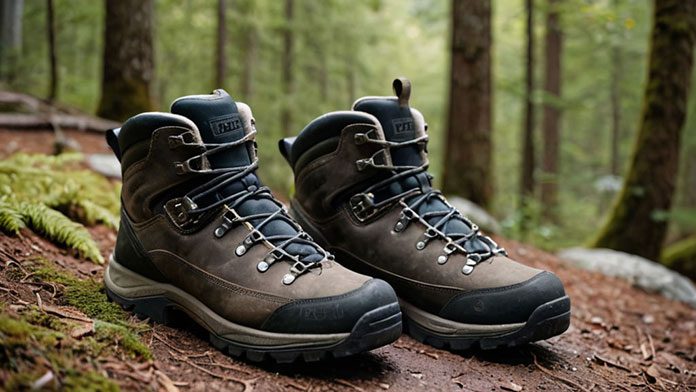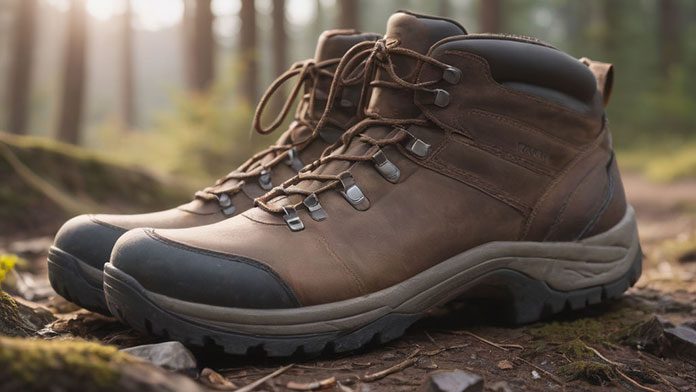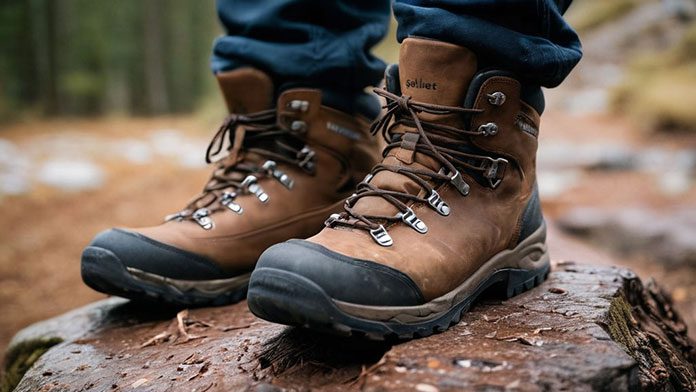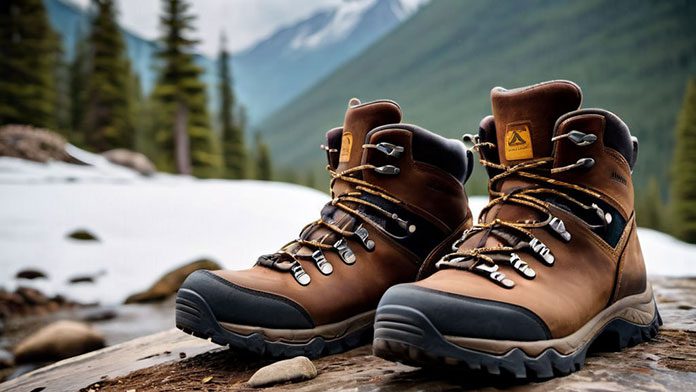Are your hiking boots on their last legs? Like a trusty old friend, your boots have carried you through countless adventures. But just how long do they really last? From the quality of materials to proper care and maintenance, there are key factors to consider.
In this article, we’ll explore the factors that determine the lifespan of your hiking boots. So lace up and get ready to hit the trails with confidence, knowing exactly what to look for in a long-lasting pair of boots.
Table of Contents

Related Video: "How long do hiking boots last?" by kernowoutdoors
Main Points
– Material quality, such as full-grain leather or synthetic fabrics, plays a significant role in the lifespan of hiking boots.
– The frequency of use affects the deterioration of boots, so having multiple pairs to rotate is beneficial.
– The terrain, weather conditions, moisture, and load carrying impact the longevity of hiking boots.
– Regular maintenance and care, including cleaning, drying, and replacing worn-out parts, are essential for prolonging the lifespan of hiking boots.
Material Quality

When it comes to the longevity of your hiking boots, the material quality is a primary factor to consider. The durability and lifespan of your boots depend heavily on the materials used in their construction. High-quality materials, such as full-grain leather or synthetic fabrics like nylon or Gore-Tex, are designed to withstand the rigors of hiking and provide optimal protection for your feet.
Hiking boots made from top-notch materials can last anywhere from 500 to 1000 miles, depending on the level of usage and terrain. Factors like the weight of your pack, the type of terrain you hike on, and how well you care for your boots can also influence their lifespan.
To determine when to replace your hiking boots, pay attention to the condition of the materials. If you notice significant wear and tear, such as cracks in the leather, separation of the sole, or loss of waterproofing, it may be time to invest in a new pair. Additionally, if you start experiencing discomfort or pain during your hikes, it could be a sign that your boots have worn out and are no longer providing adequate support.
Frequency of Use

To gauge the lifespan of your hiking boots, it’s important to consider how often you use them. The frequency of use directly impacts the wear and tear experienced by your boots. If you’re an avid hiker who hits the trails every weekend, your boots will naturally endure more stress compared to someone who hikes occasionally.
The more frequently you use your hiking boots, the faster they’ll deteriorate. This is because each time you wear them, the materials are subjected to friction, moisture, and impact. Over time, these factors can weaken the boots, causing them to lose their supportive structure and cushioning.
It is recommended that you have multiple pairs of hiking boots if you use them frequently. This allows you to rotate between boots, giving each pair time to rest and recover. By alternating your boots, you can extend their lifespan and ensure that you always have a reliable pair to wear on your adventures.
Keep in mind that the lifespan of hiking boots can vary depending on the quality of materials and construction. However, regardless of the quality, frequent use will inevitably lead to quicker deterioration. Therefore, it’s crucial to assess your usage frequency and plan accordingly to ensure that your hiking boots last as long as possible.
Terrain and Conditions

When considering how long your hiking boots will last, it’s important to take into account the terrain and conditions you’ll be facing. Different terrains and conditions can cause varying degrees of wear and tear on your boots.
From rocky and jagged trails to muddy and wet environments, each type of terrain presents its own challenges.
Additionally, the level of maintenance and care you provide for your boots can also impact their longevity in different conditions.
Wear and Tear
As you explore various terrains and encounter different conditions, the wear and tear on your hiking boots will be influenced by factors such as the type of terrain, weather conditions, and the frequency of use.
Here are five key factors to consider:
– Terrain: Rugged and rocky terrains can cause increased wear on the outsoles and midsoles of your boots. Steep inclines and descents can also put additional stress on the materials.
– Weather Conditions: Extreme temperatures, moisture, and precipitation can affect the durability of your boots. Exposure to water and prolonged dampness can lead to the breakdown of materials and the growth of mold or mildew.
– Frequency of Use: The more often you use your hiking boots, the quicker they’ll wear out. Regular use can lead to the compression and breakdown of cushioning and support materials.
– Load Carrying: Carrying heavy backpacks or equipment can put additional strain on your boots, causing them to wear out faster.
– Maintenance: Proper care and maintenance, such as cleaning and waterproofing, can help prolong the lifespan of your hiking boots.
Maintenance and Care
Taking proper care of your hiking boots is key to ensuring their longevity, especially when it comes to maintaining them in different terrains and weather conditions. The terrain and conditions you encounter during your hikes can have a significant impact on the lifespan of your boots.
When hiking on rough, rocky terrains, it’s important to regularly inspect your boots for any signs of damage, such as worn-out soles or loose stitching. Additionally, it’s crucial to clean your boots after each hike, especially if you have been trekking through muddy or wet conditions. This will help prevent the buildup of dirt and moisture, which can lead to the deterioration of the materials.
Lastly, consider applying a waterproofing treatment to protect your boots from rain, snow, and other moisture. By properly maintaining and caring for your hiking boots, you can extend their lifespan and ensure they continue to provide you with the support and comfort you need on your outdoor adventures.
Proper Care and Maintenance

To ensure the longevity of your hiking boots, it’s essential to practice proper care and maintenance.
This includes regular cleaning and drying techniques to prevent the buildup of dirt and moisture, which can lead to deterioration.
Additionally, replacing worn out parts such as laces, insoles, and outsoles will help maintain the overall functionality and performance of your boots.
Cleaning and Drying Techniques
When caring for your hiking boots, it’s important to regularly clean and dry them using proper techniques. This will help prolong their lifespan and ensure they continue to provide the support and protection you need on the trails.
Here are some key cleaning and drying techniques to keep in mind:
– Remove any loose dirt or debris from the boots using a soft brush or cloth.
– Use a mild soap or specialized boot cleaner to gently scrub away any stubborn stains or grime.
– Rinse the boots thoroughly with clean water to remove any soap residue.
After cleaning, stuff the boots with newspaper or a clean cloth to help absorb moisture and maintain their shape while drying.
Allow the boots to air dry in a well-ventilated area, away from direct heat sources, to prevent any damage to the materials.
Replacing Worn Out Parts
To ensure the longevity and optimal performance of your hiking boots, regularly replacing worn out parts is essential. Over time, certain components of your boots may start to deteriorate due to wear and tear.
The most common parts that may need replacing are the laces, insoles, and outsoles. Laces can become frayed or lose their grip, making it difficult to secure your boots properly. Insoles can wear down and lose their cushioning, resulting in discomfort and reduced support. Outsoles, the bottom part of the boots that come into contact with the ground, can wear thin or develop cracks, compromising traction and stability.
Fit and Comfort

For optimal performance and endurance on the trails, it’s crucial that your hiking boots provide a snug and comfortable fit. The fit of your boots can make or break your hiking experience, so it’s important to pay attention to the following factors:
– Size: Ensure that you choose the right size of hiking boots to prevent discomfort and blisters. Remember, your feet may swell during long hikes, so it’s advisable to try on boots in the afternoon when your feet are at their largest.
– Width: Consider the width of your feet and choose boots that accommodate them. A narrow or wide fit can cause discomfort and pain, so opt for boots that offer various width options.
– Arch support: Look for boots that provide adequate arch support to prevent fatigue and foot pain. This is especially important for hikers with high or low arches.
– Ankle support: Hiking boots with proper ankle support can prevent injuries and provide stability on uneven terrain. Look for boots with firm ankle collars or built-in ankle support.
– Break-in period: Keep in mind that hiking boots may require a break-in period before they become truly comfortable. Plan ahead and allow time for your boots to mold to your feet.
Boot Construction
To ensure the longevity of your hiking boots, pay attention to the construction of the boots. The construction of hiking boots plays a vital role in determining their durability and performance on the trails. When it comes to boot construction, there are a few key factors to consider.
Firstly, look for boots that are made with high-quality materials. Leather is a popular choice for hiking boots as it’s durable and offers excellent protection against the elements. Additionally, check the stitching of the boots. Strong, reinforced stitching ensures that the boots can withstand the rigors of hiking.
Another important aspect of boot construction is the sole. The sole provides traction and stability on various terrains. Look for boots with a well-constructed sole that offers good grip and is resistant to wear and tear. It’s also worth considering boots with a shank or a midsole that provides support and prevents foot fatigue during long hikes.
Furthermore, consider the design and construction of the upper part of the boot. Look for boots that have a reinforced toe cap and heel counter for added protection and stability. Additionally, boots with a waterproof or water-resistant construction will help keep your feet dry in wet conditions.
Brand and Manufacturing Quality
One important factor to consider when evaluating the longevity of hiking boots is the overall brand and manufacturing quality. The brand and manufacturing quality directly impact the durability and performance of the boots. Here are five key points to keep in mind when assessing the brand and manufacturing quality of hiking boots:
– Reputation: A reputable brand often signifies a commitment to quality and customer satisfaction. Look for brands that have a strong track record in producing reliable and long-lasting hiking boots.
– Materials: The quality of materials used in the manufacturing process greatly affects the durability of hiking boots. Opt for boots made from high-quality leather or synthetic materials that can withstand the rigors of hiking.
– Construction: Pay attention to the construction techniques employed by the manufacturer. Boots that feature solid stitching, reinforced toe caps, and sturdy soles are likely to last longer.
– Quality Control: A brand that prioritizes quality control ensures that each pair of boots meets high standards. Look for brands that have stringent quality control measures in place to minimize defects and ensure consistent quality.
– Customer Reviews: Reading customer reviews can provide valuable insights into the overall brand and manufacturing quality. Take note of any recurring complaints or praises regarding the longevity and durability of the boots.
Considering these factors will help you make an informed decision and invest in hiking boots that are built to last.
Signs of Wear and Tear
When assessing the longevity of your hiking boots, it is important to be aware of the signs of wear and tear that may indicate the need for replacement. Regular inspections can help you catch these signs before they become major issues and potentially compromise your safety on the trails. Here are some common signs of wear and tear to look out for:
| Signs of Wear and Tear | What to Look For |
|---|---|
| Outsole wear and tear | Excessive wear or smoothness on the outsole |
| Upper material damage | Cracked leather, torn fabric, or loose stitching |
| Insole breakdown | Loss of cushioning or support |
| Heel and toe box wear | Excessive wear or deformation in these areas |
| Sole separation from the upper | Separation between the outsole and the upper |
If you notice any of these signs during your inspections, it may be time to consider replacing your hiking boots. Remember, a well-maintained and properly functioning pair of boots is crucial for a comfortable and safe hiking experience. Regular cleaning, conditioning, and proper storage can help prolong the lifespan of your boots, but eventually, wear and tear will take its toll. So, keep an eye out for these signs and prioritize your safety on the trails.
Frequently Asked Questions
Can Hiking Boots Be Used for Activities Other Than Hiking?
Yes, hiking boots can be used for activities other than hiking. They are versatile and provide good support and traction. However, keep in mind that excessive use for non-hiking activities may decrease their lifespan.
How Do I Know if My Hiking Boots Need to Be Resoled?
If your hiking boots feel less stable or slip more frequently, it may be time to resole them. Check for excessive wear on the outsole or if the tread is worn down.
Are There Any Special Cleaning Techniques for Hiking Boots Made of Synthetic Materials?
To clean synthetic hiking boots, start by removing dirt and debris with a brush or damp cloth. Then, use a mild detergent and warm water to scrub away stains. Rinse and air dry.
Can I Wear Hiking Boots in Wet and Muddy Conditions?
You can wear hiking boots in wet and muddy conditions, but it's important to consider the material and construction. Look for boots with waterproof features and durable soles to ensure your feet stay dry and secure.


